Submitted:
24 July 2023
Posted:
25 July 2023
You are already at the latest version
Abstract
Keywords:
1. Introduction
2. Components Methodology
2.1. DC Power
2.2. AC Power
2.3. Daily Yield
2.4. Ambient Temperature
2.5. Module Temperature
2.6. Solar Radiation
3. Proposed Intelligent Methods
3.1. Elman Neural Network (ENN)
3.2. Boosted Tree Algorithms (BTA)
3.3. Multi-later Perceptron (MLP)
3.4. Gaussian Processes Regression (GPR)
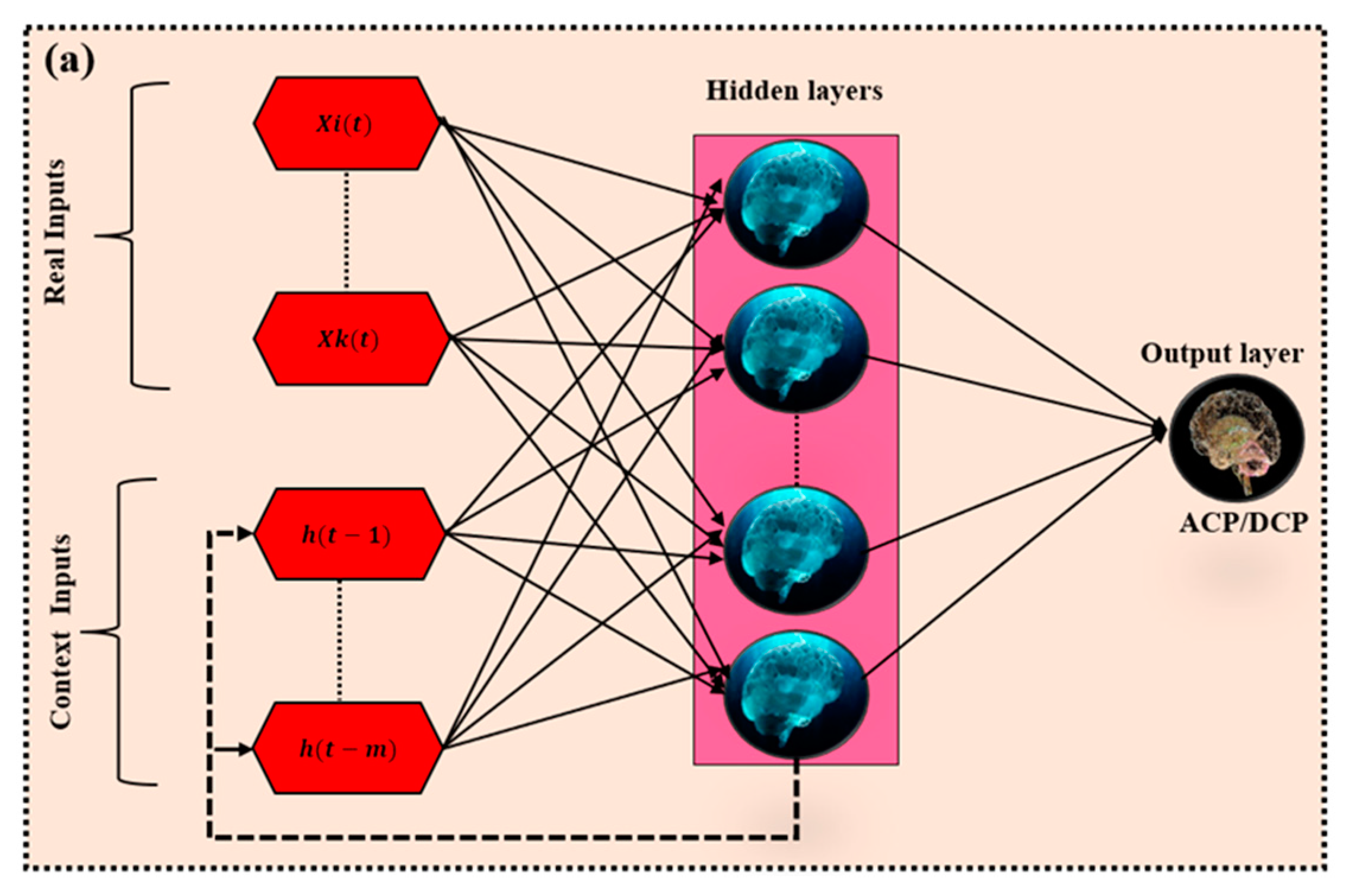
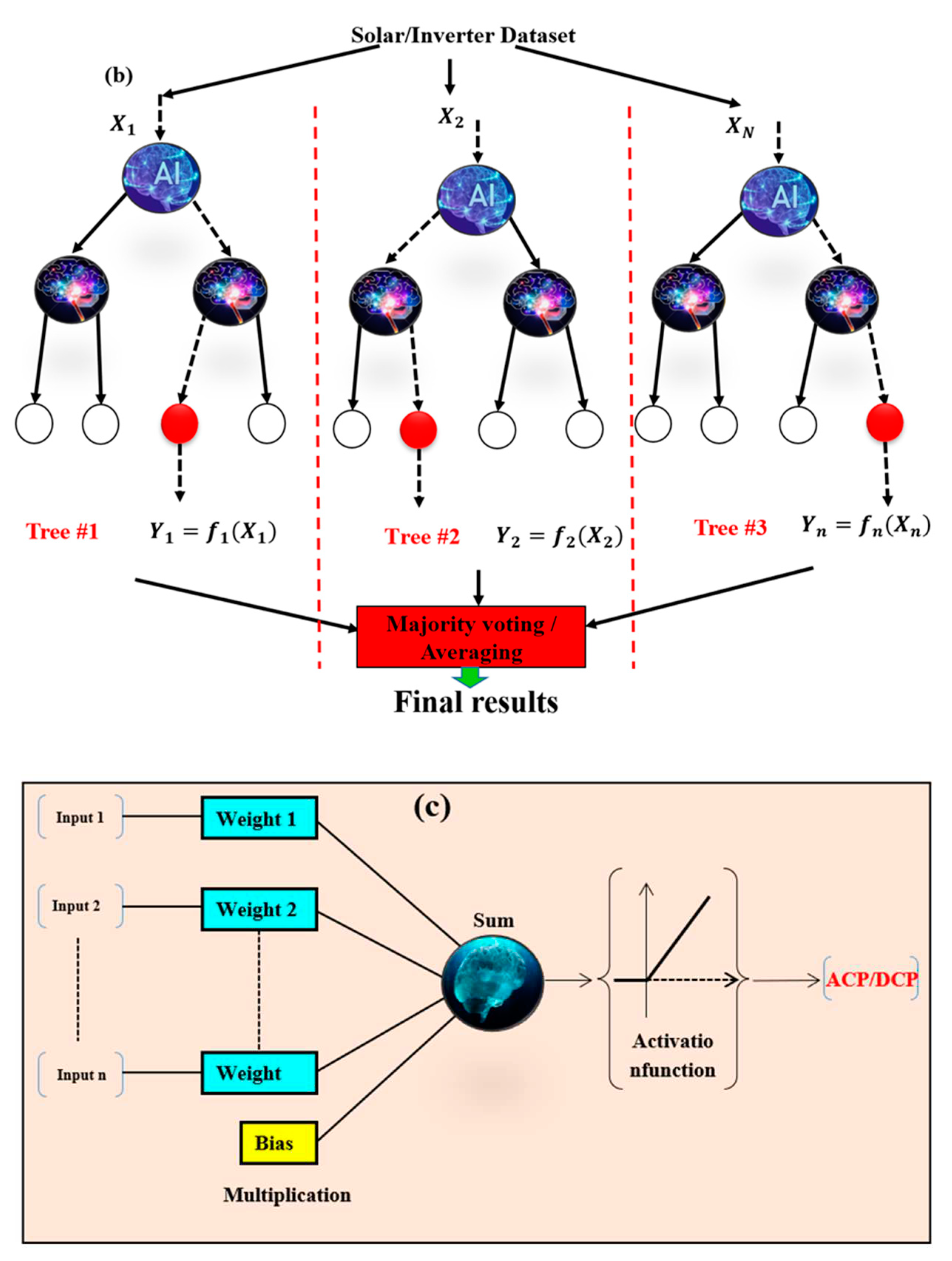
4. Application of Results and Discussion
4.1. Preliminary Results
4.2. Results of Intelligent Leaning-Scenario I
4.3. Results of Intelligent Leaning-Scenario II
5. Conclusions
Author Contributions
Funding
Institutional Review Board Statement
Informed Consent Statement
Data Availability Statement
Acknowledgments
Conflicts of Interest
References
- A. Abubakar, C. F. M. Almeida, and M. Gemignani, “Review of Artificial Intelligence-Based Failure Detection and Diagnosis Methods for Solar Photovoltaic Systems,” Machines, vol. 9, no. 12, p. 328, Dec. 2021. [CrossRef]
- D. Feldman, K. Dummit, J. Zuboy, J. Heeter, K. Xu, and R. Margolis, “Spring 2022 Solar Industry Update,” 2022.
- D. Feldman, K. Dummit, J. Zuboy, and R. Margolis, “Winter 2023 Solar Industry Update,” 2023.
- Y. Zhao, R. Ball, J. Mosesian, J. de Palma, and B. Lehman, “Graph-Based Semi-supervised Learning for Fault Detection and Classification in Solar Photovoltaic Arrays,” IEEE Trans. Power Electron., vol. 30, no. 5, pp. 2848–2858, 2015. [CrossRef]
- B. Taghezouit, F. Harrou, Y. Sun, A. H. Arab, and C. Larbes, “A simple and effective detection strategy using double exponential scheme for photovoltaic systems monitoring,” Sol. Energy, vol. 214, no. December 2020, pp. 337–354, 2021. 20 December. [CrossRef]
- M. Abbas and D. Zhang, “A smart fault detection approach for PV modules using Adaptive Neuro-Fuzzy Inference framework,” Energy Reports, vol. 7, pp. 2962–2975, 2021. [CrossRef]
- D. Korkmaz and H. Acikgoz, “An efficient fault classification method in solar photovoltaic modules using transfer learning and multi-scale convolutional neural network,” Eng. Appl. Artif. Intell., vol. 113, no. April, p. 104959, 2022. [CrossRef]
- A. Mellit, “An embedded solution for fault detection and diagnosis of photovoltaic modules using thermographic images and deep convolutional neural networks,” Eng. Appl. Artif. Intell., vol. 116, no. June, p. 105459, 2022. [CrossRef]
- D. Manno, G. Cipriani, G. Ciulla, V. Di Dio, S. Guarino, and V. Lo Brano, “Deep learning strategies for automatic fault diagnosis in photovoltaic systems by thermographic images,” Energy Convers. Manag., vol. 241, no. May, p. 114315, 2021. [CrossRef]
- A. Mellit and S. Kalogirou, “Artificial intelligence and internet of things to improve efficacy of diagnosis and remote sensing of solar photovoltaic systems: Challenges, recommendations and future directions,” Renewable and Sustainable Energy Reviews, vol. 143, no. January. Elsevier Ltd, p. 110889, 2021. [CrossRef]
- A. G. Olabi et al., “Artificial neural networks applications in partially shaded PV systems,” Thermal Science and Engineering Progress, vol. 37, no. May 2022. Elsevier Ltd, p. 101612, 2023. [CrossRef]
- A. Mellit and S. Kalogirou, “Assessment of machine learning and ensemble methods for fault diagnosis of photovoltaic systems,” Renew. Energy, vol. 184, pp. 1074–1090, 2022. [CrossRef]
- L. Hocine, K. M. Samira, M. Tarek, N. Salah, and K. Samia, “Automatic detection of faults in a photovoltaic power plant based on the observation of degradation indicators,” Renew. Energy, vol. 164, pp. 603–617, 2021. [CrossRef]
- S. Naveen Venkatesh, B. Rebecca Jeyavadhanam, A. M. Moradi Sizkouhi, S. M. Esmailifar, M. Aghaei, and V. Sugumaran, “Automatic detection of visual faults on photovoltaic modules using deep ensemble learning network,” Energy Reports, vol. 8, pp. 14382–14395, 2022. [CrossRef]
- S. Sarikh, M. Raoufi, A. Bennouna, and B. Ikken, “Characteristic curve diagnosis based on fuzzy classification for a reliable photovoltaic fault monitoring,” Sustain. Energy Technol. Assessments, vol. 43, no. November 2020, p. 100958, 2021. [CrossRef]
- A. Seghiour, H. A. Abbas, A. Chouder, and A. Rabhi, “Deep learning method based on autoencoder neural network applied to faults detection and diagnosis of photovoltaic system,” Simul. Model. Pract. Theory, vol. 123, no. September 2021, p. 102704, 2023. [CrossRef]
- S. Jadidi, H. Badihi, and Y. Zhang, “Design of an intelligent hybrid diagnosis scheme for cyber-physical PV systems at the microgrid level,” Int. J. Electr. Power Energy Syst., vol. 150, no. October 2022, p. 109062, 2023. [CrossRef]
- X. Lu et al., “Efficient fault diagnosis approach for solar photovoltaic array using a convolutional neural network in combination of generative adversarial network under small dataset,” Sol. Energy, vol. 253, no. February 2022, pp. 360–374, 2023. [CrossRef]
- D. O. Tojeiro, R. T. Cabeza, and A. S. Potts, “Fault detection based on Neuro-Fuzzy models and residual evaluation with fuzzy thresholds applied to a photovoltaic system,” in IFAC-PapersOnLine, 2021, vol. 54, no. 20, pp. 717–722. [CrossRef]
- Y. Liu et al., “Fault diagnosis approach for photovoltaic array based on the stacked auto-encoder and clustering with I-V curves,” Energy Convers. Manag., vol. 245, p. 114603, 2021. [CrossRef]
- N. Kellil, A. Aissat, and A. Mellit, “Fault diagnosis of photovoltaic modules using deep neural networks and infrared images under Algerian climatic conditions,” Energy, vol. 263, no. PC, p. 125902, 2023. [CrossRef]
- V. Nourani, G. Elkiran, and S. I. Abba, “Wastewater treatment plant performance analysis using artificial intelligence – an ensemble approach,” Water Sci. Technol., 2018. [CrossRef]
- L. Q. Shen, G. Amatulli, T. Sethi, P. Raymond, and S. Domisch, “Estimating nitrogen and phosphorus concentrations in streams and rivers, within a machine learning framework,” Sci. Data, vol. 7, no. 1, pp. 1–12, 2020. [CrossRef]
- M. Wang, L. Ma, M. Strokal, W. Ma, X. Liu, and C. Kroeze, “Hotspots for Nitrogen and Phosphorus Losses from Food Production in China: A County-Scale Analysis,” Environ. Sci. Technol., vol. 52, no. 10, pp. 5782–5791, 2018. [CrossRef]
- J. Zhou, Y. Zhang, K. Wu, M. Hu, H. Wu, and D. Chen, “National estimates of environmental thresholds for upland soil phosphorus in China based on a meta-analysis,” Sci. Total Environ., vol. 780, p. 146677, 2021. [CrossRef]
- Y. Zhang et al., “Estimation of nitrogen runoff loss from croplands in the Yangtze River Basin: A meta-analysis,” Environ. Pollut., vol. 272, no. xxxx, p. 116001, 2021. [CrossRef]
- G. Elkiran, V. Nourani, and S. I. Abba, “Multi-step ahead modelling of river water quality parameters using ensemble artificial intelligence-based approach,” J. Hydrol., vol. 577, no. July, p. 123962, 2019. [CrossRef]
- G. R. Rakhshandehroo, M. Vaghefi, and M. A. Aghbolaghi, “Forecasting Groundwater Level in Shiraz Plain Using Artificial Neural Networks,” Arab. J. Sci. Eng., vol. 37, no. 7, pp. 1871–1883, 2012. [CrossRef]
- P. Di et al., “Ultra-Short Term Load Forecasting Based on Elman Neural Network,” 2019 IEEE PES Innov. Smart Grid Technol. Asia, ISGT 2019, vol. 2, pp. 911–915, 2019. [CrossRef]
- H. Jia and B. Taheri, “Model identification of Solid Oxide Fuel Cell using hybrid Elman Neural Network/Quantum Pathfinder algorithm,” Energy Reports, vol. 7, pp. 3328–3337, 2021. [CrossRef]
- J. Wang, W. Zhang, Y. Li, J. Wang, and Z. Dang, “Forecasting wind speed using empirical mode decomposition and Elman neural network,” Appl. Soft Comput. J., vol. 23, pp. 452–459, 2014. [CrossRef]
- A. O. Alnahit, A. K. Mishra, and A. A. Khan, “Stream water quality prediction using boosted regression tree and random forest models,” Stoch. Environ. Res. Risk Assess., vol. 4, 2022. [CrossRef]
- J. Elith, J. R. Leathwick, and T. Hastie, “A working guide to boosted regression trees,” J. Anim. Ecol., vol. 77, no. 4, pp. 802–813, 2008. [CrossRef]
- I.K. Umar, V. Nourani, H. Gökçekuş, and S. I. Abba, “An intelligent hybridized computing techniques for the prediction of roadway traffic noise based on non-linear mutual information,” vol. 5, 2022. [CrossRef]
- A. Mosavi, P. Ozturk, and K. W. Chau, “Flood prediction using machine learning models: Literature review,” Water (Switzerland), vol. 10, no. 11, pp. 1–40, 2018. [CrossRef]
- U. Stańczyk, B. Zielosko, and L. C. Jain, Advances in feature selection for data and pattern recognition: An introduction, vol. 138. 2018.
- W. S. Kemal and M. Alhasa, SPRINGER BRIEFS IN METEOROLOGY Modeling of Tropospheric Delays Using ANFIS. 2016.
- A. Elbeltagi et al., “Applications of Gaussian process regression for predicting blue water footprint: Case study in Ad Daqahliyah, Egypt,” Agric. Water Manag., vol. 255, 2021. [CrossRef]
- K. Kargar et al., “Estimating longitudinal dispersion coefficient in natural streams using empirical models and machine learning algorithms,” Eng. Appl. Comput. Fluid Mech., vol. 14, no. 1, pp. 311–322, 2020. [CrossRef]
- E. Momeni, M. B. Dowlatshahi, F. Omidinasab, H. Maizir, and D. J. Armaghani, “Gaussian Process Regression Technique to Estimate the Pile Bearing Capacity,” Arab. J. Sci. Eng., vol. 45, no. 10, pp. 8255–8267, 2020. [CrossRef]
- C. Huang, Z. Zhao, L. Wang, Z. Zhang, and X. Luo, “Point and interval forecasting of solar irradiance with an active Gaussian process,” IET Renew. Power Gener., vol. 14, no. 6, pp. 1020–1030, 2020. [CrossRef]
- A.G. Usman, S. IŞIK, and S. I. Abba, “Qualitative prediction of Thymoquinone in the high-performance liquid chromatography optimization method development using artificial intelligence models coupled with ensemble machine learning,” Sep. Sci. Plus, no. June, pp. 1–9, 2022. [CrossRef]
- S. I. Abba, G. Elkiran, and V. Nourani, “Improving novel extreme learning machine using pca algorithms for multi-parametric modeling of the municipal wastewater treatment plant,” Desalin. Water Treat., vol. 215, no. March, pp. 414–426, 2021. [CrossRef]
- K. Bala, I. Etikan, and A. G. Usman, “Artificial-Intelligence-Based Models Coupled with Correspondence Analysis Visualization on ART — Cases from Gombe State , Nigeria : A Comparative Study,” 2023.
- M. Saood et al., “New generation neurocomputing learning coupled with a hybrid neuro-fuzzy model for quantifying water quality index variable : A case study from Saudi Arabia,” Ecol. Inform., vol. 70, no. May, p. 101696, 2022. [CrossRef]
- A. Alamrouni, F. Aslanova, S. Mati, H. S. Maccido, and A. A. Jibril, “Multi-Regional Modeling of Cumulative COVID-19 Cases Integrated with Environmental Forest Knowledge Estimation : A Deep Learning Ensemble Approach,” Int. J. Environ. Res. Public Heal., vol. 19(2), pp. 1–23, 2022. [CrossRef]
- A. G. Usman, M. H. Ahmad, N. Danraka, and S. I. Abba, “The effect of ethanolic leaves extract of Hymenodictyon floribundun on inflammatory biomarkers : A data - driven approach,” Bull. Natl. Res. Cent., 2021. [CrossRef]
- M. Dhimish, V. Holmes, B. Mehrdadi, and M. Dales, “Diagnostic method for photovoltaic systems based on six layer detection algorithm,” Electr. Power Syst. Res., vol. 151, pp. 26–39, 2017. [CrossRef]
- D. Adhya, S. Chatterjee, and A. K. Chakraborty, “Performance assessment of selective machine learning techniques for improved PV array fault diagnosis,” Sustain. Energy, Grids Networks, vol. 29, p. 100582, 2022. [CrossRef]
- S. L. P, S. S, and M. S. Rayudu, “IoT based solar panel fault and maintenance detection using decision tree with light gradient boosting,” Meas. Sensors, vol. 27, no. November 2022, p. 100726, 2023. [CrossRef]
- M. Karamirad, M. Omid, R. Alimardani, H. Mousazadeh, and S. N. Heidari, “ANN based simulation and experimental verification of analytical four- and five-parameters models of PV modules,” Simul. Model. Pract. Theory, vol. 34, pp. 86–98, 201. [CrossRef]
- M. S. Gaya et al., “Estimation of water quality index using artificial intelligence approaches and multi-linear regression,” vol. 9, no. 1, pp. 126–134, 2020. [CrossRef]
- S. I. Abba et al., “Modelling of Uncertain System: A comparison study of Linear and Non-Linear Approaches,” 2019 IEEE Int. Conf. Autom. Control Intell. Syst. I2CACIS 2019 - Proc., no. October, pp. 1–6, 2019. [CrossRef]
- M. S. Gaya, N. A. Wahab, Y. Sam, and S. I. Samsuddin, “Comparison of ANFIS and Neural Network Direct Inverse Control Applied to Wastewater Treatment System,” vol. 845, pp. 543–548, 2014. [CrossRef]
- Arévalo, D. Benavides, M. Tostado-Véliz, J. A. Aguado, and F. Jurado, “Smart monitoring method for photovoltaic systems and failure control based on power smoothing techniques,” Renew. Energy, vol. 205, no. October 2022, pp. 366–383, 2023. 20 October. [CrossRef]
- H. Adamu, I. Abba, and B. Anyin, “Energy Advances of high-performance electrochemical energy storage systems through feature engineering of multiple descriptor families of materials,” 2023. [CrossRef]
- Abdullahi, G. Elkiran, S. I. Malami, A. Rotimi, S. I. Haruna, and S. I. Abba, “Compatibility of Hybrid Neuro-Fuzzy Model to Predict Reference Evapotranspiration in Distinct Climate Stations,” pp. 1–6, 2022. [CrossRef]
- S. I. Malami, F. H. Anwar, S. Abdulrahman, S. I. Haruna, S. I. A. Ali, and S. I. Abba, “Implementation of hybrid neuro-fuzzy and self-turning predictive model for the prediction of concrete carbonation depth: A soft computing technique,” Results Eng., vol. 10, no. May, p. 100228, 2021. [CrossRef]
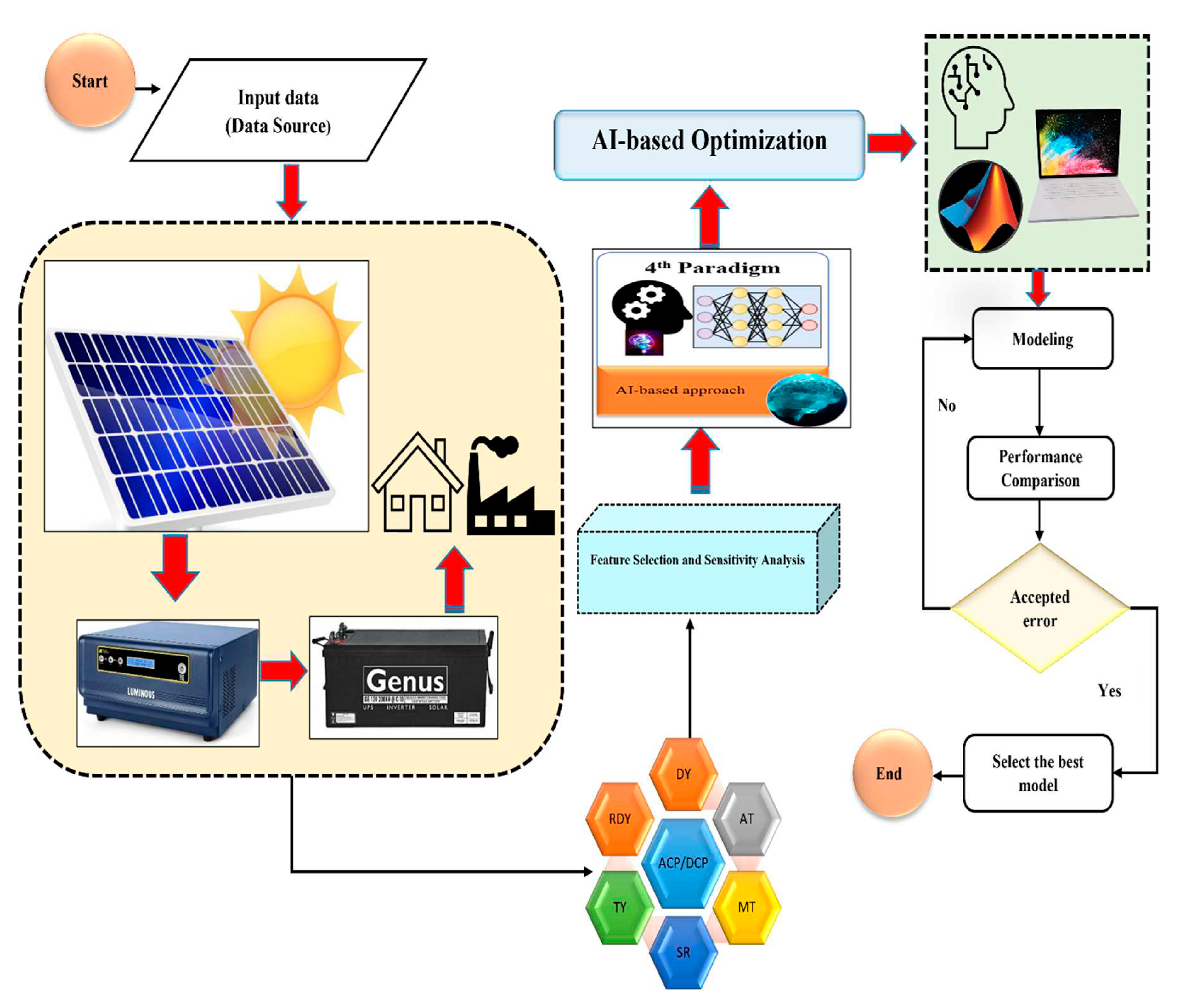
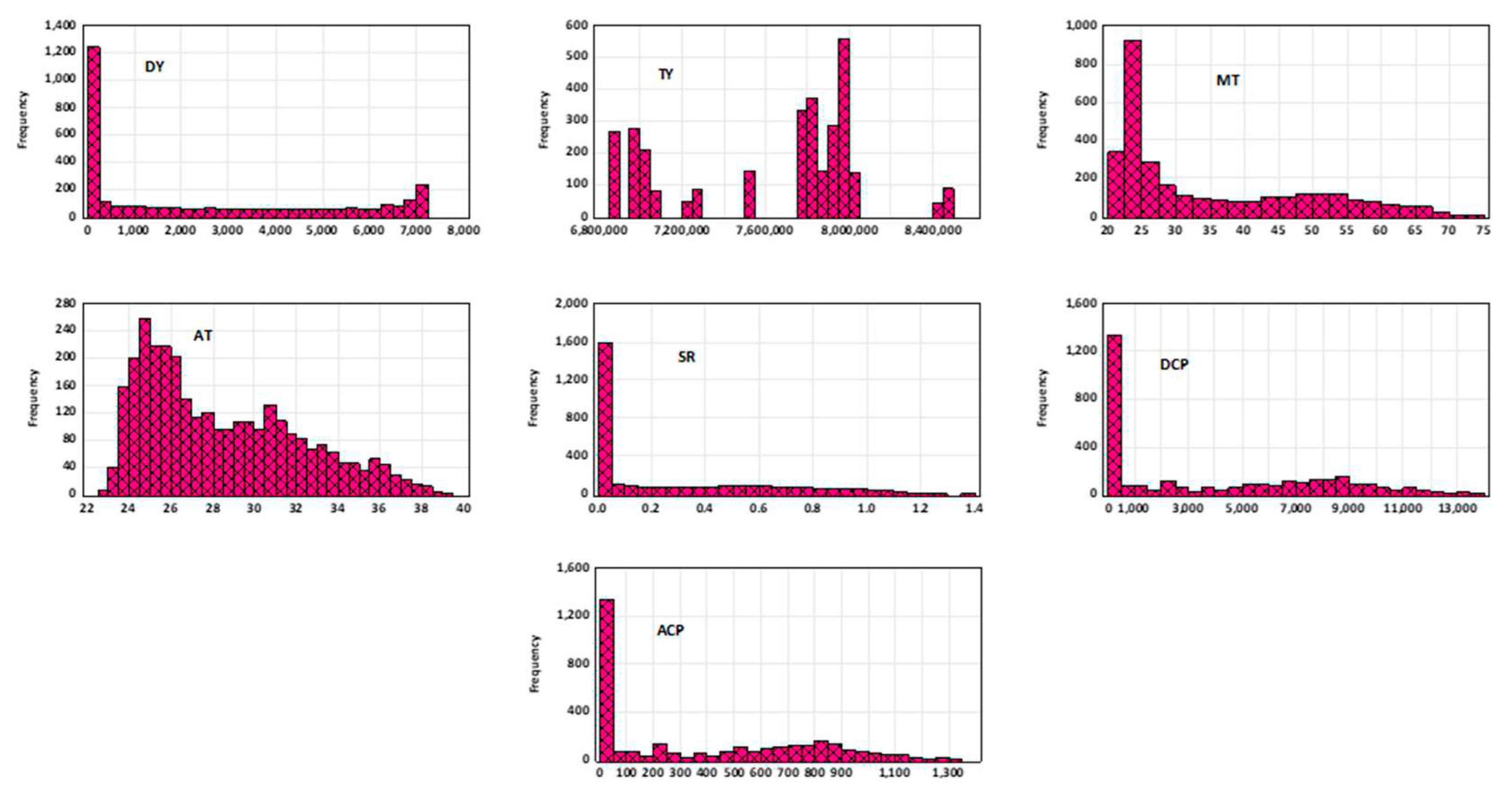
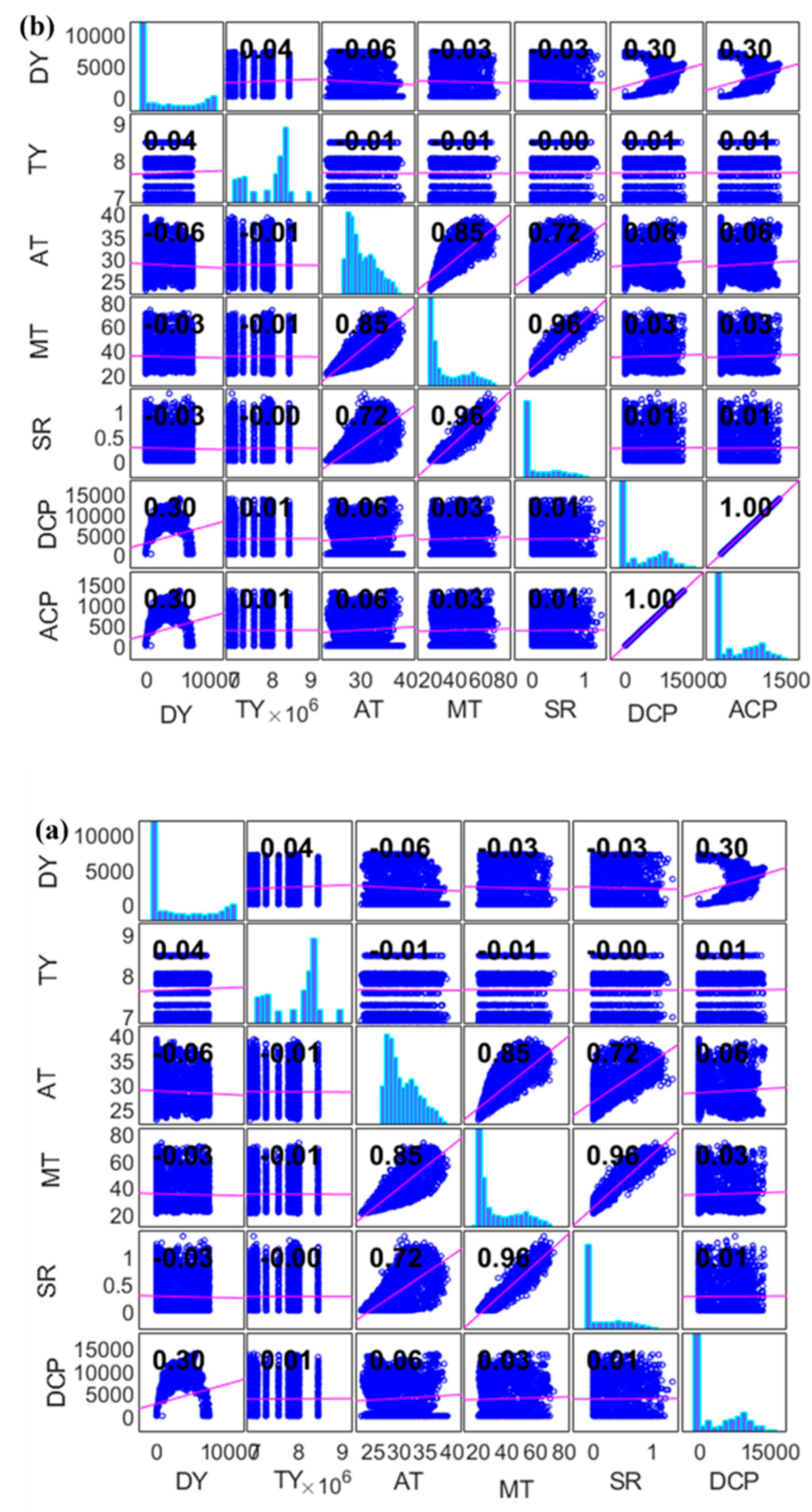
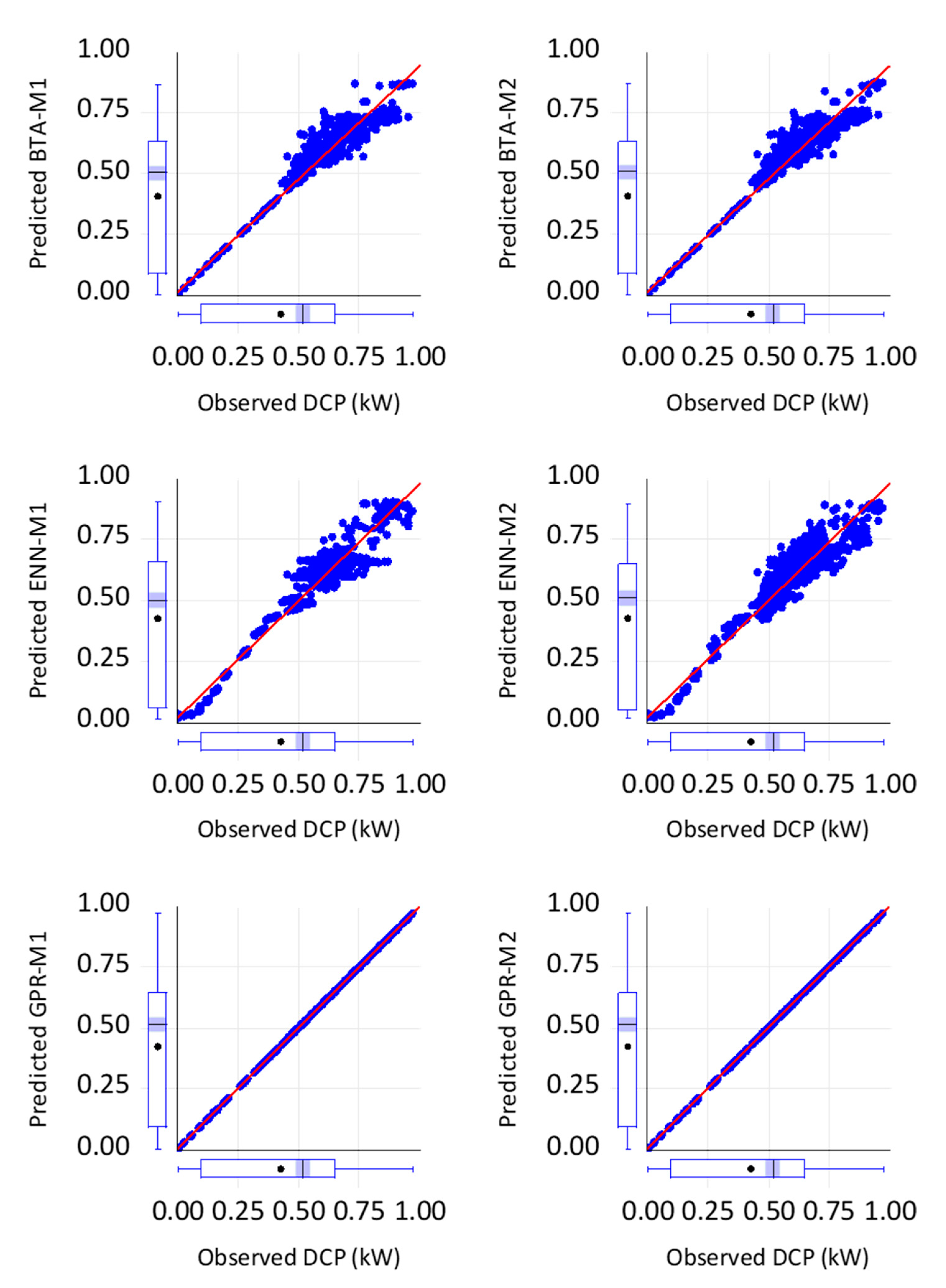
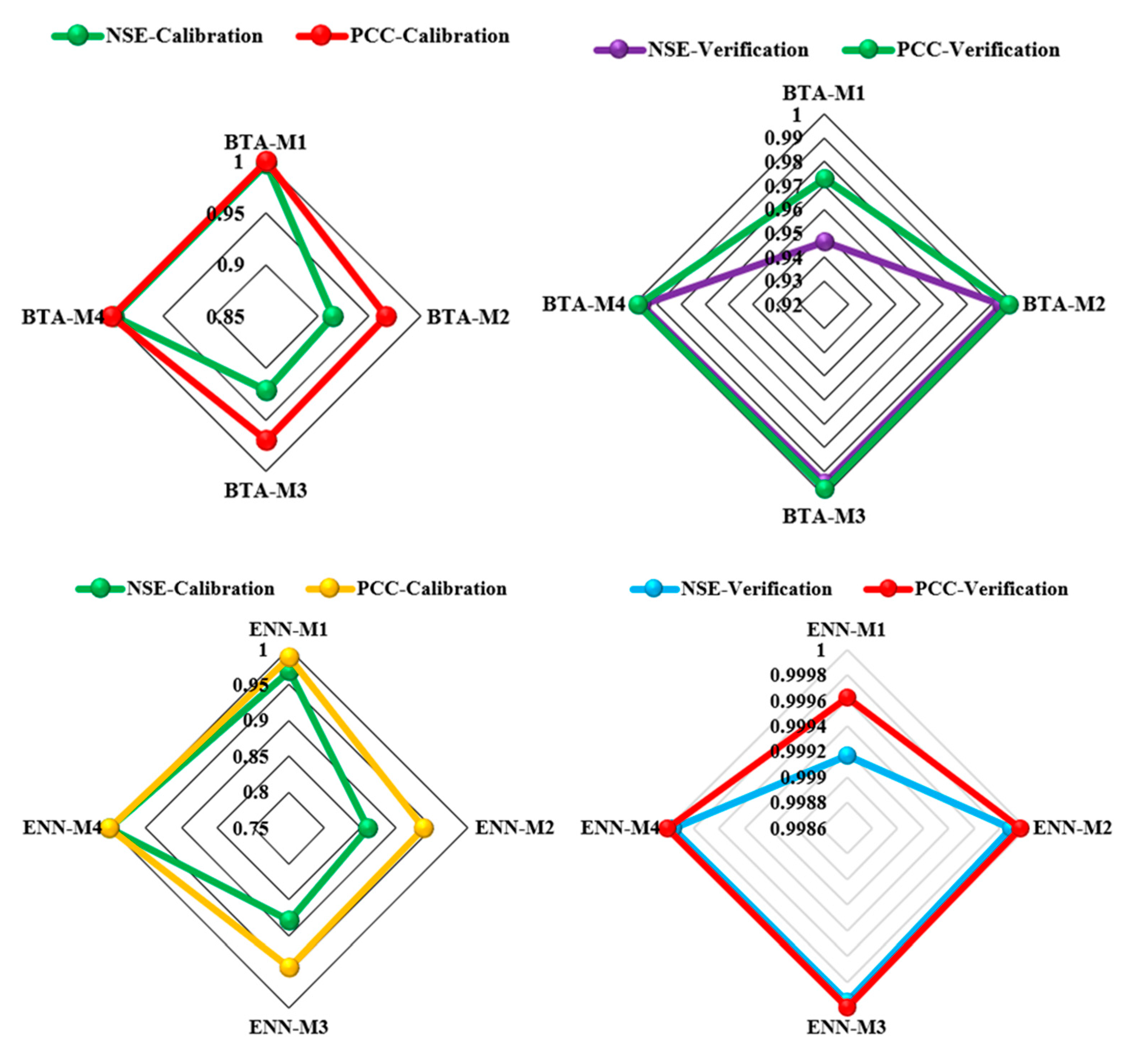
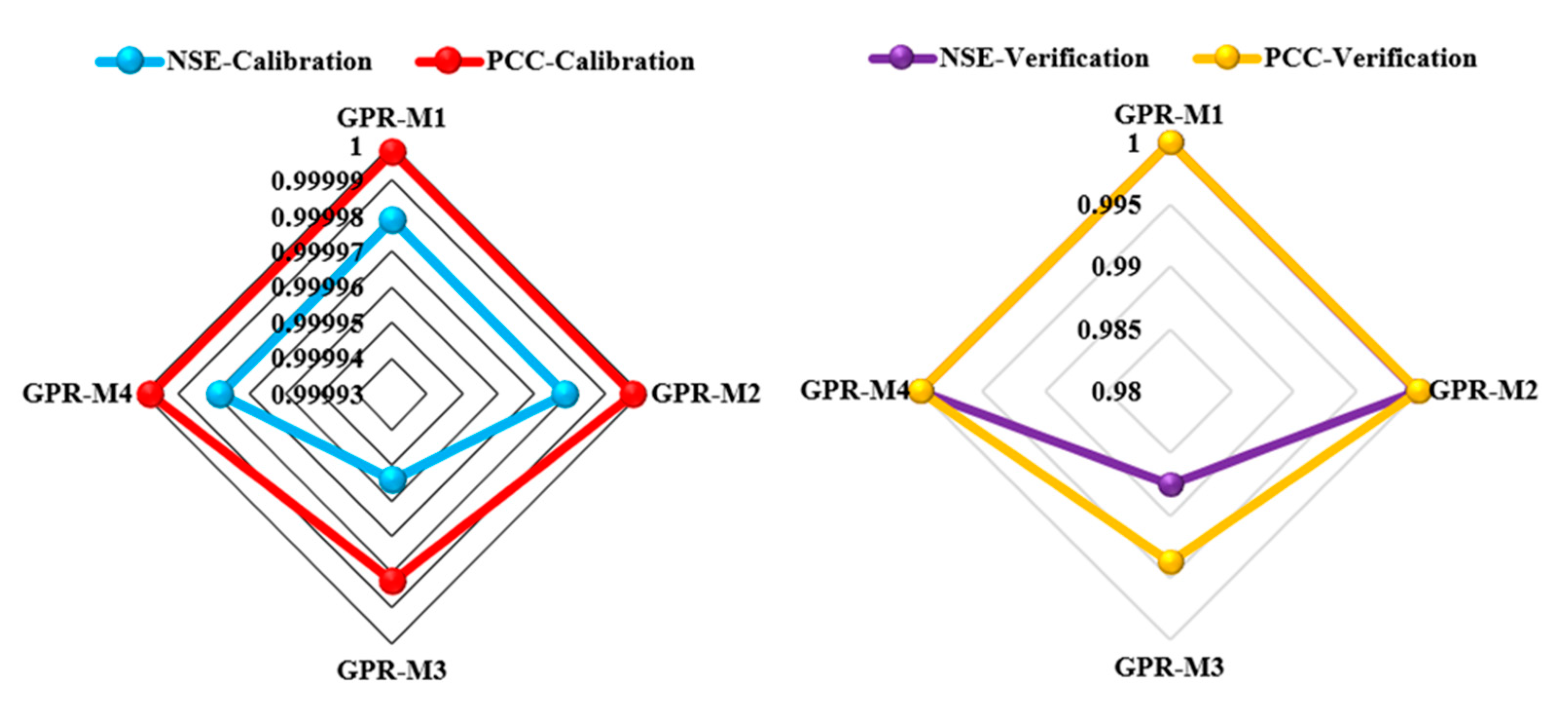
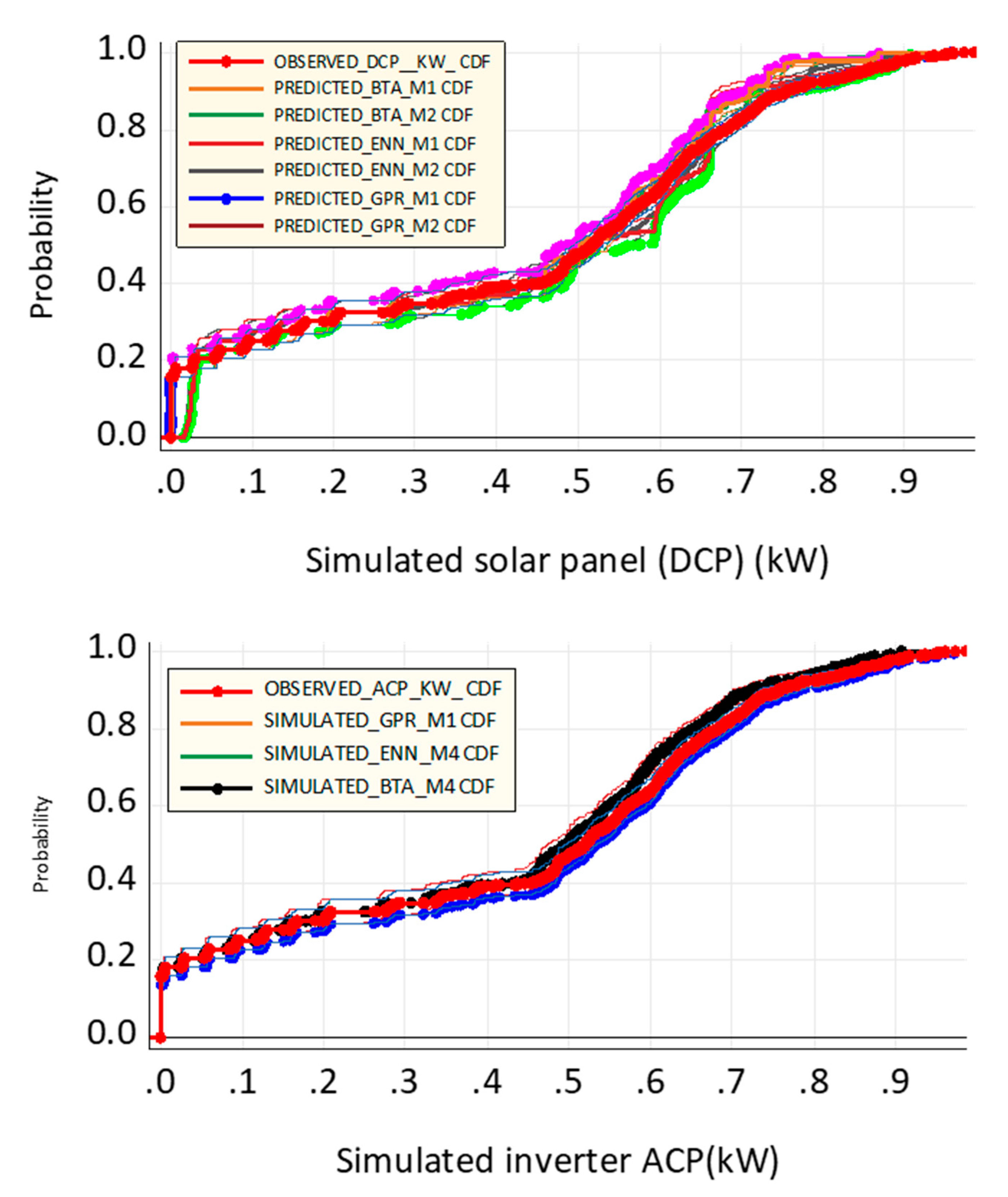
| Parameters | Mean | SD | Kurtosis | Skewness | Minimum | Maximum |
|---|---|---|---|---|---|---|
| DY | 2401.47 | 2667.09 | -1.20 | 0.64 | 0.00 | 7190.00 |
| TY | 7620392.92 | 451795.89 | -1.05 | -0.45 | 6870716.67 | 8460553.49 |
| AT | 28.42 | 3.75 | -0.54 | 0.67 | 22.67 | 39.17 |
| MT | 34.65 | 13.71 | -0.65 | 0.85 | 20.16 | 72.83 |
| SR | 0.26 | 0.34 | -0.21 | 1.05 | 0.00 | 1.36 |
| DCP | 3775.04 | 4045.64 | -1.20 | 0.52 | 0.00 | 13687.94 |
| ACP | 369.50 | 395.76 | -1.21 | 0.52 | 0.00 | 1334.94 |
| Calibration Phase | ||||||
|---|---|---|---|---|---|---|
| NSE | PCC | RMSE | MAPE | MAE | PBIAS | |
| BTA-M1 | 0.914 | 0.967 | 0.072 | 35.267 | 0.043 | 0.044 |
| BTA-M2 | 0.921 | 0.970 | 0.070 | 33.745 | 0.041 | 0.044 |
| ENN-M1 | 0.973 | 0.990 | 0.045 | 22.100 | 0.019 | -58.588 |
| ENN-M2 | 0.971 | 0.989 | 0.047 | 22.528 | 0.021 | -69.997 |
| GPR-M1 | 1.000 | 1.000 | 0.000 | 29.597 | 0.000 | 0.000 |
| GPR-M2 | 1.000 | 1.000 | 0.002 | 29.711 | 0.001 | 0.000 |
| Verification Phase | ||||||
| NSE | PCC | RMSE | MAPE | MAE | PBIAS | |
| BTA-M1 | 0.969 | 0.989 | 0.049 | 6.876 | 0.031 | 17460.222 |
| BTA-M2 | 0.969 | 0.989 | 0.048 | 6.866 | 0.031 | 17140.021 |
| ENN-M1 | 0.968 | 0.985 | 0.051 | 22.150 | 0.039 | -58.638 |
| ENN-M2 | 0.966 | 0.984 | 0.053 | 22.578 | 0.041 | -70.047 |
| GPR-M1 | 1.000 | 1.000 | 0.000 | 0.083 | 0.000 | 0.000 |
| GPR-M2 | 1.000 | 1.000 | 0.000 | 0.091 | 0.000 | 0.000 |
| Calibration Phase | ||||||
|---|---|---|---|---|---|---|
| NSE | PCC | RMSE | MAPE | MAE | PBIAS | |
| BTA-M1 | 0.997 | 1.000 | 0.014 | 27.247 | 0.008 | 0.040 |
| BTA-M2 | 0.915 | 0.966 | 0.073 | 35.294 | 0.043 | 0.040 |
| BTA-M3 | 0.921 | 0.969 | 0.070 | 34.136 | 0.041 | 0.040 |
| BTA-M4 | 0.997 | 1.000 | 0.014 | 27.247 | 0.008 | 0.040 |
| ENN-M1 | 0.970 | 0.988 | 0.046 | 43.989 | 0.043 | -0.066 |
| ENN-M2 | 0.860 | 0.939 | 0.094 | 43.518 | 0.063 | -0.021 |
| ENN-M3 | 0.880 | 0.945 | 0.090 | 36.625 | 0.059 | -0.012 |
| ENN-M4 | 1.000 | 1.000 | 0.001 | 28.886 | 0.001 | -0.004 |
| GPR-M1 | 1.000 | 1.000 | 0.001 | 29.721 | 0.001 | -0.004 |
| GPR-M2 | 1.000 | 1.000 | 0.001 | 29.731 | 0.001 | -0.004 |
| GPR-M3 | 1.000 | 1.000 | 0.002 | 29.820 | 0.001 | -0.004 |
| GPR-M4 | 1.000 | 1.000 | 0.001 | 29.733 | 0.001 | -0.004 |
| Verification Phase | ||||||
| NSE | PCC | RMSE | MAPE | MAE | PBIAS | |
| BTA-M1 | 0.947 | 0.973 | 0.061 | 10.091 | 0.095 | 101.107 |
| BTA-M2 | 0.995 | 0.997 | 0.088 | 6.069 | 0.018 | 801.107 |
| BTA-M3 | 0.995 | 0.997 | 0.088 | 5.085 | 0.017 | 60.107 |
| BTA-M4 | 0.997 | 0.998 | 0.020 | 4.291 | 0.013 | 30.107 |
| ENN-M1 | 0.999 | 1.000 | 0.008 | 6.424 | 0.006 | -57.560 |
| ENN-M2 | 1.000 | 1.000 | 0.003 | 1.397 | 0.003 | -49.126 |
| ENN-M3 | 1.000 | 1.000 | 0.002 | 1.205 | 0.002 | -42.401 |
| ENN-M4 | 1.000 | 1.000 | 0.002 | 0.506 | 0.002 | -42.302 |
| GPR-M1 | 1.000 | 1.000 | 0.002 | 0.363 | 0.002 | -2.542 |
| GPR-M2 | 1.000 | 1.000 | 0.003 | 1.006 | 0.002 | -173.542 |
| GPR-M3 | 0.988 | 0.994 | 68.185 | 1.006 | 2.281 | 87.330 |
| GPR-M4 | 1.000 | 1.000 | 0.002 | 0.393 | 0.002 | -23.542 |
Disclaimer/Publisher’s Note: The statements, opinions and data contained in all publications are solely those of the individual author(s) and contributor(s) and not of MDPI and/or the editor(s). MDPI and/or the editor(s) disclaim responsibility for any injury to people or property resulting from any ideas, methods, instructions or products referred to in the content. |
© 2023 by the authors. Licensee MDPI, Basel, Switzerland. This article is an open access article distributed under the terms and conditions of the Creative Commons Attribution (CC BY) license (http://creativecommons.org/licenses/by/4.0/).





